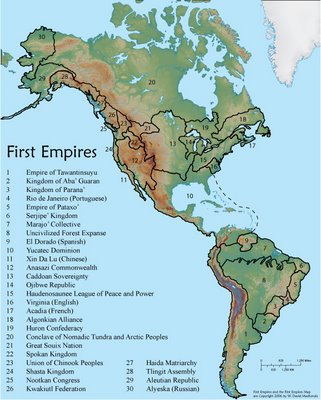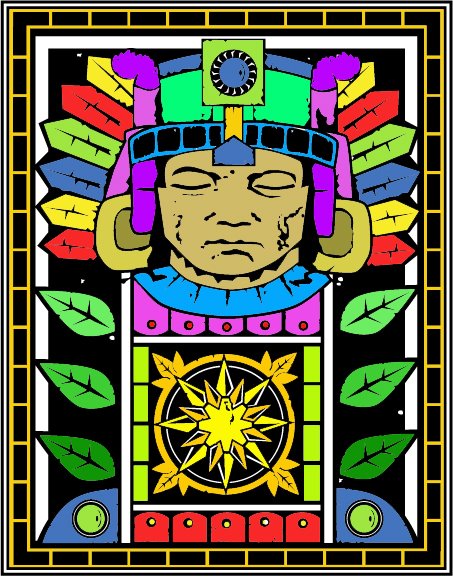First Empires: An Alternate History Shared World

Every alternate history scenario has a “Point of Departure” (POD) where the timeline diverges from our own history. In First Empires, the primary POD occurred between 15,000 BC and 10,000 BC. During this post-ice age period certain key North and South American mammals DID NOT become extinct through over-hunting as they did on our Earth and survived in numbers sufficient to benefit indigenous cultural evolution.
Horses, Camels, and Mastodons were used as transportation, beasts of burden, and instruments of war. Woodland Musk Ox, Peccaries, and Tapirs were domesticated for livestock animals. The American continents already had abundant domesticated crops including, maize, beans, squash, quinoa, potatoes, maygrass, chilies, and cotton.
This seemingly simple change allowed the indigenous civilizations to advance on par with European and Asian cultures. Subsistence hunting and gathering yielded more quickly to agrarian ways of life and then to regional states and true nations. Technology advanced steadily as growing native cultures came into contact through peaceful trade and territorial or ideological warfare. Close association with herd and livestock animals gave Americans rudimentary inoculation to a variety of diseases and made them more robust when Old and New World cultures came into contact during the Age of Discovery.
In the end, Old World expansionism did not find a continent ripe for plundering. England, Portugal, and Spain established trading colonies on the east coasts; Chinese explorers settled the southwestern coast; and Russians hopped across the Bering Straight into the arctic northwest. For the most part, however, the indigenous cultures stood their ground and maintained their national borders largely intact.
There are also three secondary POD’s in the First Empires milieu.
#1 Certain North and South American cryptids are real and known to the indigenous peoples. For example: Sasquatch are tribes of reclusive hominids somewhat lower than humans on the evolutionary scale; Chupacabra are giant semi-flightless bats that hunt and mutilate the livestock of Anasazi and Yucatec ranchers; and Terror Birds are a surviving prehistoric species of ten-foot tall flightless predatory birds stalking the South American jungles.
What does not exist in the First Empires milieu are mythological and fairy tale beasties and peoples. No dwarves or elves. No unicorns or dragons. No satyrs or cyclops.
#2 Spirits and tribal magic real and sensitive people, through the use of ritual and ceremony, can act as conduits for communication and interaction between the real world and the spirit world. When we speak of “tribal magic” we’re not talking about the Merlin or Swords and Sorcery style of magic. Tribal magic is elaborate ritual chanting and drumming and dancing, peyote intoxication and vision quests, mystical séances with crystal balls and tarot and runes stones. Tribal magic takes time, takes energy, and takes a practitioner who is in tune with the world beyond our five senses. You know them as shamans, witch doctors, medicine men, gypsies, mediums, astrologers, palmists, mystics, seers, fortunetellers, mundunugus, sangomas, bomohs, witches, and voodoo priests.
The spirits themselves are the other half of the tribal magic team. They are the vital energy that animates our flesh and blood, Freed of their earthly bonds but not ready to move on to their great reward, they linger on the edge of the physical world. Some carry anger or love or fear around with them and ooze these emotions into our perceptions. Some are helpful and communicative, some are malicious or mischievous, and still others go about their business as if they did not know that their bodies were dead and gone. Some spirits are tied to a place or person, others are free to come and go as they like. Some spirits require tribal magic to interact with our world and others require tribal magic to stop their otherworldly rampages or to set them on the path to peace and rest.
God, gods, demons, angels, and the like do not interact with man in First Empires. Certainly there are religions here, all the familiar ones from the real world and a few new ones too, but religion is a matter of faith, a question of what lies beyond this world and the spirit world. Mischievous or confused spirits may play at “Acts of God” but the truly Devine has a “hands off” policy in the First Empires milieu.
#3 Throughout history people have made important discoveries or inventions and then failed to realize the full potential of their creations. Chinese Sky Lanterns, used in religious ceremonies or as wartime signaling systems, were precursors to the hot air balloon and were invented 1,600 years before the Montgolfier Brothers first floated over Paris. The Aeolipile was the first recorded steam powered engine and it was invented by Heron of Alexandria 1,600 years before James Watt’s steam engine. The Baghdad Battery was use to generate low voltage electricity for electroplating and has been dated to 1,800 years before Alassandro Volta created his Voltic Pile. In each case the original inventors, or society in general, failed to see the possibilities of these devices and they became mere historical curiosities.
In First Empires, however, our equally inventive cultures carried these discoveries a few steps further. Our Yucatec also invented sky lanterns for religious observances and then saw how the same principal, on a much larger scale, could be used to lift engineers into the sky above their pyramid complexes to guide their city construction projects, thus giving rise to hot air ballooning centuries before the French. The Caddoans, witnessing how jets of steam from geyser vents exerted force on nearby vegetation, developed a device like the Aeolipile to recreate this effect and have developed rudimentary steam jet powered railroads way ahead of the English. The Anasazi developed a pottery battery for electroplating their jewelry and trade goods then refined the battery and put it to many other uses such as electrified spears a millennium before our modern taser.
I’m certain there are other technologies that were invented, abandoned, and reinvented over the five thousand years of human civilization and I look forward to the creative, but still logical, development of such devices in the stories that will be written for First Empires.

